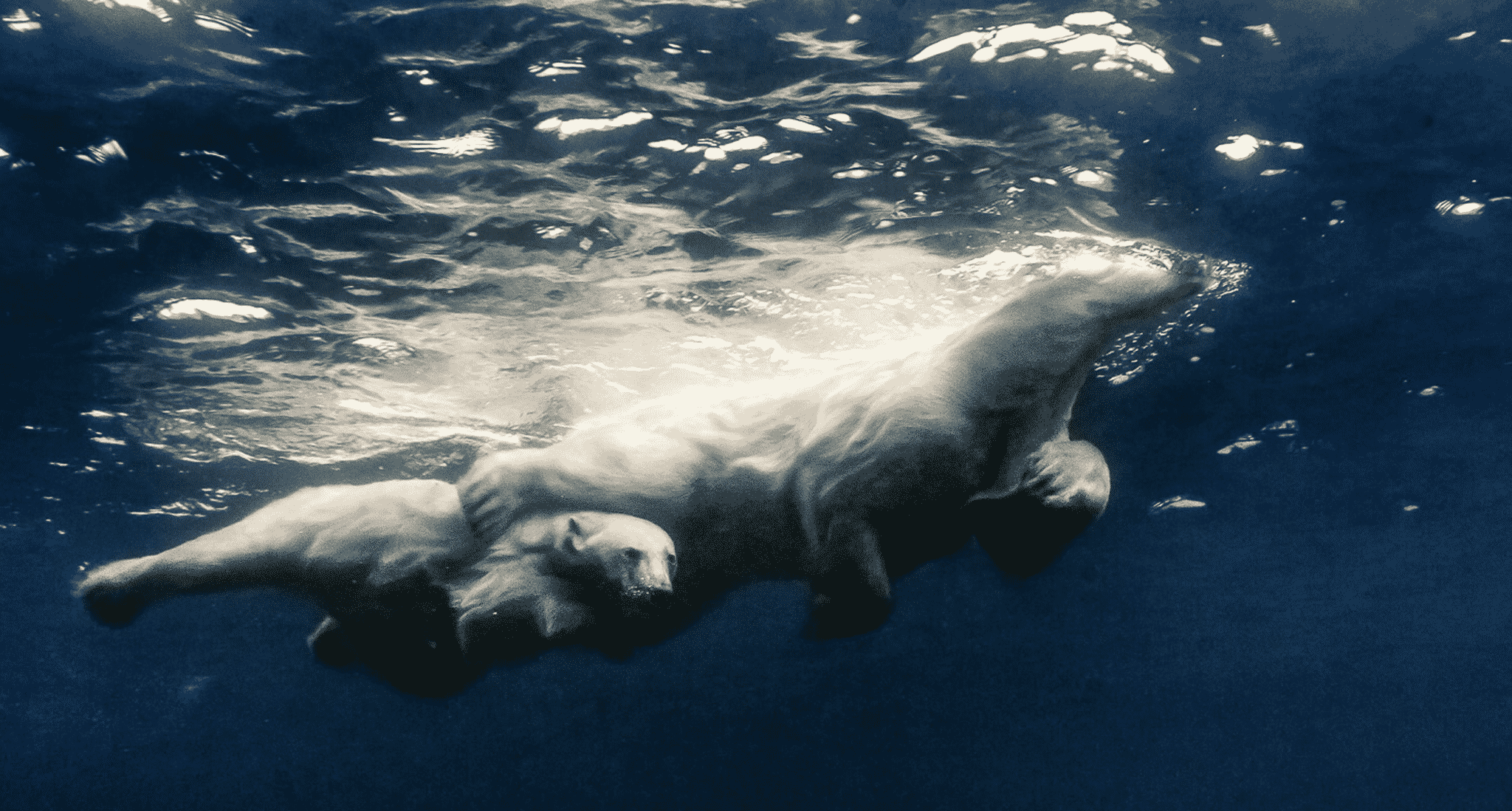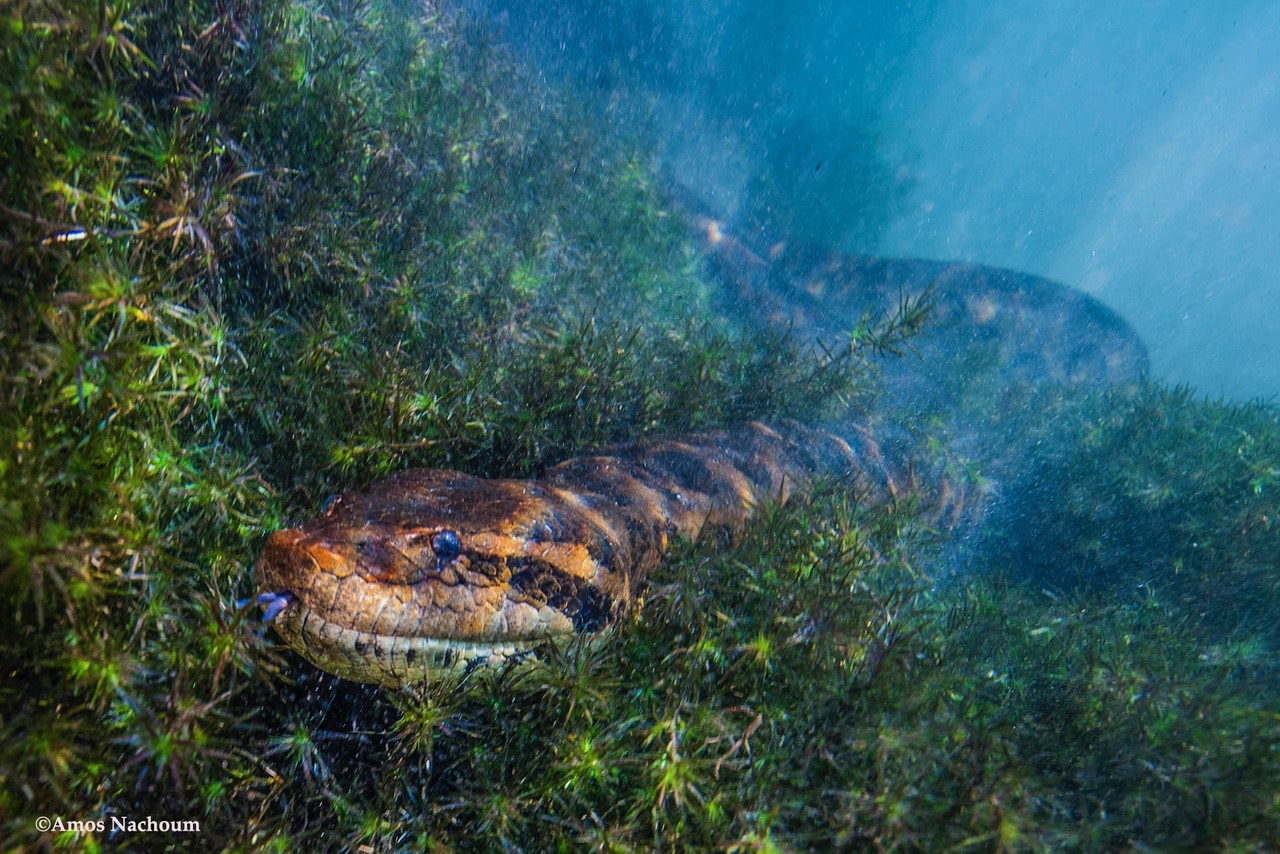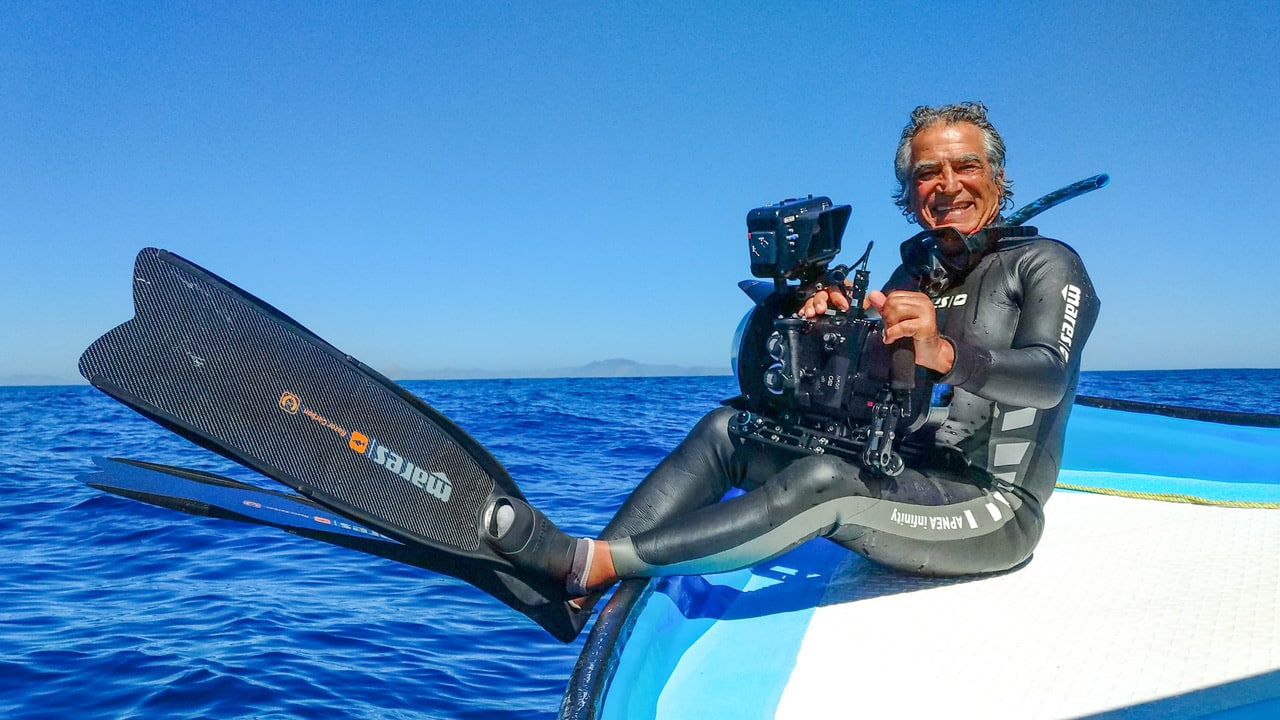 Amos Nachoum photographed a Polar Bear family swimming. Credit: Amos Nachoum
Amos Nachoum photographed a Polar Bear family swimming. Credit: Amos Nachoum Despite photographing snow leopards, Bengal tigers and jaguars up close and personal without protective gear, photojournalist/conservationist Amos Nachoum proclaims that, contrary to popular belief, he isn’t suicidal nor does he flirt with danger.
“If I was drawn to danger, I’d be dead by now,” the Israeli-born Nachoum told the Journal by phone from his home in Monterey, Calif. “I want to dispel the myth of dangerous wildlife, but it takes a lot of planning and patience. No animal is dangerous to people. People endanger themselves because they misbehave toward animals.”
He points out, for example, that it’s not uncommon for encaged photographers (sometimes with scuba diving tourists in tow) to hurl bloodied tuna fish slabs into the water to attract Great White Sharks, which in turn become agitated and aggressive. It’s an artificial situation spawned at the animal’s expense in order to create a photo op and bring in the big bucks.
However, he stressed, “I’m not fearless. In the [Israeli] army, I learned fear puts you on high alert and that’s a good thing, but you also have to know when fear is necessary. The first time I faced a great white shark unprotected, I discovered how wonderfully freeing and safe it was.”

Set in the Canadian arctic on a land and seascape that’s spare and desolate and frozen, the visually striking, award-winning documentary, “Picture of His Life” (directed by Dani Menkin and Yonatan Nir) zeros in on Nachoum as he prepares to become the first still photographer to shoot the polar bear while swimming with one in open water. It’s been an obsessive desire over decades. “Only five people have swum with polar bears,” he said. “There have been far more men on the moon.”
Interspersed through the film, he recounts his military service during the Yom Kippur War (’73) and the long, scarring shadow it has cast. The film also touches on his estranged relationship with his late father who had little use for his son’s profession or lifestyle as a single, child-free man.
Without leaning on it the film evokes a driven and contradictory figure who has found solace and inspiration through nature at its wildest and paradoxically most pure and innocent. He is a humanist who is most at home in the ocean. He is a minimalist.
Nachoum’s photos have appeared in such publications as National Geographic, Time, Life and The New York Times among many others. A fashion and war photojournalist, he initially was drawn to the sea as a career move. But he also felt its restorative strength. The blueness of the water, its clarity and, yes, just his ability to float on top of the water, all of it in stark contrast to the sun-baked, dry, brown dusty desert that he identified with Israel in general and his tour of duty in particular. It was a tonic, a revelation.

He wanted to share its beauty with the world and later when he saw the damage to the coral reef and the absence of fish that had previously been there he was determined to spread the word on that too. Not coincidentally, he conducts scuba diving/photography cruises all over the globe.
Polar bears, of course, have their own mythology, Nachoum said. To Westerners, they represent huge, dangerous animals to be feared; to the Inuit, polar bears are threatening but also awe-inspiring. For Nachoum, they aroused curiosity, raising questions about what their family lives were like, their shared levels of intimacy and how they expressed it.
The odds of finding a polar bear family were slim and the clock was ticking, but the team persevered, sitting in a small boat in the Arctic Sea watching the polar bears moving from island to island, climbing the rocks, finding food and then disappearing into the waters. Finally, a polar bear family came into view. Nachoum and his videographer slipped into the water and swam toward the mama bear and her two cubs and then stopped.
“We were 200 yards away,” Nachoum recalled. “The mother bear looked at us. The baby bears looked at us. It was silent, nobody moved and then she and the babies swam toward us. Our eyes were on each other and then, when she was about 10 feet away, we swam 15 feet beneath the surface and started shooting as she and the two cubs swam directly above us. She was about nine feet tall and weighed anywhere between 800 and 1,000 pounds. But what most struck me was how she was pushing the water with her front legs, her dark brown claws visible. At the same time, her rear legs, submerged in water, did the steering. At one point she was holding one of the babies on her side. They cared for each other and they were not threatening to us. All of it gave me confidence that my understanding of the wilderness is correct.”

Nachoum hopes the film serves as an antidote to Hollywood’s vision, specifically Steven Spielberg’s “Jaws,” and its legacy of untamed wildlife as the monster.
Spielberg’s sister, Nancy, who served as executive producer on the film, said only half kidding, the documentary represents her apology on behalf of the family name. Identified with Jewish-Israeli themed films (from “On the Map” to “Who Will Write Our History?”), she said Nachoum’s story resonates with her on several fronts: her love of animals, the environmental motifs and the interconnectedness of families (for good and bad). As a Jew, she was moved by the Inuits who served as guides, with their deeply rooted tribal elements, the close-knit relationship between the grandfather and grandson, and the adherence to tradition in the face of potential extinction.
Making the film represented a labor of love for all the players, most pointedly for Israeli-born directors Nir and Menkin, each of whom boasts many credits and had previously partnered on “Dolphin Boy,” a documentary that also celebrates the nature.
Beyond the limited budget, time restraints, unforgiving conditions (five days on the water, heavy rains, subfreezing gusts of wind) and the very real possibility that none of it would work, their challenge was to learn something about Nachoum, an intensely private figure who revealed very little until they arrived in the Arctic. Inexplicably mystic, the natural setting in all its rawness made it possible for him to open up about his wartime experiences, his father and the healing powers of nature.
“Of course, he had to reassure us that we wouldn’t be eaten by polar bears,” Menkin said. “You have to understand I cannot go into a pool that’s not heated and New York winters still traumatize me. In the Arctic, I felt I was walking on the moon. But I connected with Amos as an artist, his focus and determination.”
He was further fascinated by him as an almost prototypical Sabra-born Israeli: the young boy brought up to serve the country, revere the military and develop a thick skin as a survival tactic in a harsh place where equivocation and sensitivity are viewed as weakness.

“At the same time, he was able to transform himself in a totally unique way,” Menkin said. “Still, like many Jews, he was brought up to believe he had to make the world a better place.”
Nir echoed his views, although his connection with Nachoum is more personal. They first met years earlier as fellow photojournalists, but when Nir served in the army, he was traumatized by the loss of life and his serious injury sustained in a landmine explosion, and he contacted Nachoum for support and they shared a special bond. Nachoum urged him to become a filmmaker.
The polar bear trip was life-altering for all. Nir said he never had a greater appreciation of nature and that through Nachoum’s singular lens he saw “the beauty and grace of magnificent animals like polar bears in a brand new way and understood that we are all part of one animal kingdom.”
As for Nachoum, whose future adventures include filming Siberian tigers, clouded leopards and blue whales, he said that with each wildlife encounter he’s increasingly humbled and feels his own solitude most keenly, even at the very moment he experiences an inarticulate connectedness with the universe.
“Picture of His Life” premieres at Laemmle Virtual Cinema on June 19. For more information, click here.
Simi Horwitz is a New York-based, award-winning feature writer/film reviewer.






















 More news and opinions than at a Shabbat dinner, right in your inbox.
More news and opinions than at a Shabbat dinner, right in your inbox.